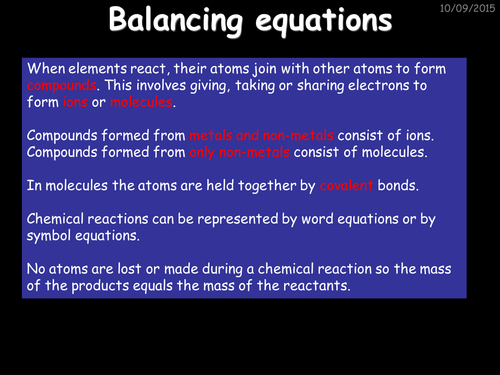


The third lesson in 'The Fundamental Ideas in Chemistry' topic looking at how atoms can join together using elections, how to show them as chemical reactions and how to ensure they are balanced.
Lesson objectives:
-When elements react, their atoms join with other atoms to form compounds. This involves giving, taking or sharing electrons to form ions or molecules.
-Compounds formed from metals and non-metals consist of ions. Compounds formed from only non-metals consist of molecules.
-In molecules the atoms are held together by covalent bonds.
-Chemical reactions can be represented by word equations or by symbol equations.
-No atoms are lost or made during a chemical reaction so the mass of the products equals the mass of the reactants.
Resources included:
1. Powerpoint with starter reviewing work on electron arrangement and testing current student understanding of chemical reactions. Explanation of molecules, ions and simple bonding before going into balanced equations. Some equations to balance on the ppt. and links to websites that do the same thing.
2. Quick true or false quiz to use as plenary.
3. Worksheet to practice balancing equations.
Lesson objectives:
-When elements react, their atoms join with other atoms to form compounds. This involves giving, taking or sharing electrons to form ions or molecules.
-Compounds formed from metals and non-metals consist of ions. Compounds formed from only non-metals consist of molecules.
-In molecules the atoms are held together by covalent bonds.
-Chemical reactions can be represented by word equations or by symbol equations.
-No atoms are lost or made during a chemical reaction so the mass of the products equals the mass of the reactants.
Resources included:
1. Powerpoint with starter reviewing work on electron arrangement and testing current student understanding of chemical reactions. Explanation of molecules, ions and simple bonding before going into balanced equations. Some equations to balance on the ppt. and links to websites that do the same thing.
2. Quick true or false quiz to use as plenary.
3. Worksheet to practice balancing equations.
Something went wrong, please try again later.
This resource hasn't been reviewed yet
To ensure quality for our reviews, only customers who have purchased this resource can review it
Report this resourceto let us know if it violates our terms and conditions.
Our customer service team will review your report and will be in touch.
£2.00
